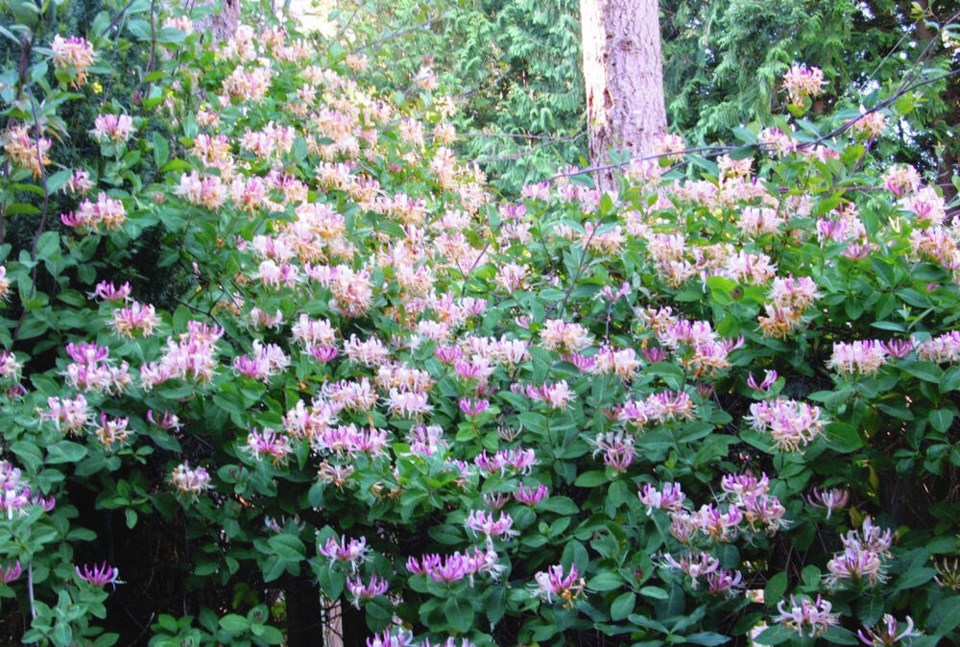Dear Helen: I have a honeysuckle that did not flower in its first year in the garden, and it put on little growth. last fall, I moved it to a sunny location, where it grew well but produced few flowers and only until early July. What to do? B.L.
It is not unusual for a honeysuckle vine to take two or three years from planting to flowering. Ideal growing conditions include full sun to part shade and a fertile, humus-rich, moist but well-drained soil.
A lack of bloom after a plant’s settling-in time can most often be attributed to insufficient exposure to sunlight, a dry soil, or/and too much nitrogen in the soil.
In its first two years, vining honeysuckles need only enough pruning to create and retain the shape you want and to keep growth within the support system you have for it. After that, trimming away of dead flowers can be done following a significant bloom period, and pruning in late winter or early spring to shape and thin the plant as needed. With time, some pruning out of the oldest (thickest) stems is helpful.
Dear Helen: Over the summer I heard and read often about the importance of mulching in gardens. Why was the practice emphasized so widely? Is there any specific “best” time for mulching?
S.C.
Mulching simply means covering the soil. For home gardeners, organic materials that will protect the soil and enhance its health are used.
Autumn mulching aims to protect the soil in plots cleared of summer vegetables and flowers. Pounding fall and winter rains can damage a soil’s texture and leach out its nutrients. A buffer of loose organic materials like small or chopped leaves, straw, or shredded plant material can deflect some of the harm.
In the spring, when beds are about to be prepared for planting, the winter mulch can be dug under if it has almost completely decomposed. Otherwise, it can be either composted or set aside for using as a mulch around summer vegetables like tomatoes and squash.
Mulching takes on another important role in late spring and early summer, when the growing season is underway and the soil is warming. An organic mulch of loose leaves, grass clippings mixed with aged sawdust or wood shavings, or a nourishing compost laid over the soil around plantings helps to control weeds, conserve soil moisture, and moderate soil temperatures. As the materials decompose, they also contribute to the health and fertility of the soil.
My preference, before hot weather, is to boost soil and plant health with a high quality compost mulch around plantings, topped by a cooling, moisture retaining material like loose straw or fluffy leaves.
It was the extreme and unexpected heat starting in June that prompted so much discussion about mulching, a practice that is one of the best protective measures we have for our soils and plants. If extreme heat waves persist, I expect we’ll all be looking into shading measures as well for out summer plantings.
Dear Helen: Is it true that sales of peat for gardening are going to be banned in some places?
D.S.
Peat sales are slated to stop in the United Kingdom in 2024. Peat harvesting over the years has degraded their peatlands, and the harvesting releases carbon dioxide.
Peatlands are major carbon storehouses, making them protectors of a livable climate. They also are havens of safety for wildlife and plant diversity. The U.K. is planning to restore, as much as it is possible, its degraded peatlands as harvesting is phased out.
Already growers in the U.K. and elsewhere have begun a transition from peat to coir (coconut husk fibre), which is a valuable moisture-retaining, temperature-moderating ingredient in both garden soils and potting mixes. It is widely available where garden supplies are sold.
Dear Helen: Should I remove the top growth on my carrots and cover the roots for the winter?
R.L.
I leave top growth on the carrots as long as it is green, and clear it away once it has withered. Then I cover the roots with a shallow layer of soil, marking the corners with stakes to avoid accidentally disturbing the roots and also to guide carrot digging over the winter.
As freezing weather approaches, it’s wise to mulch over the bed to further protect the root tops from damage. Chopped leaves or straw are examples of suitable insulating mulches.



